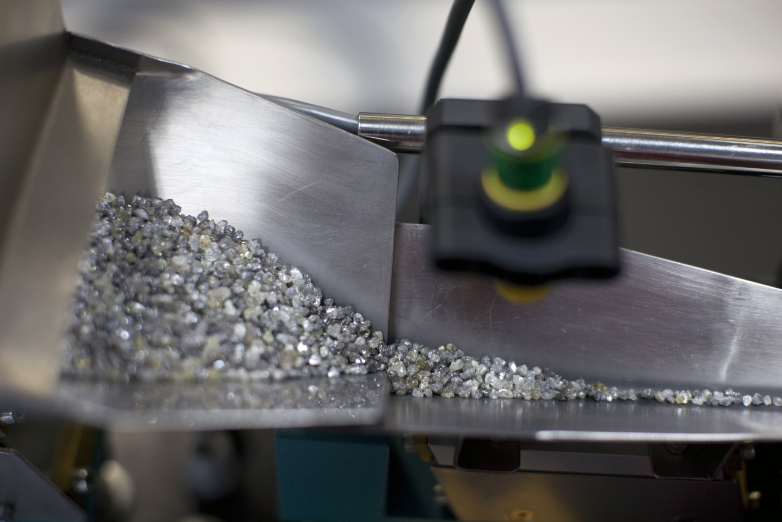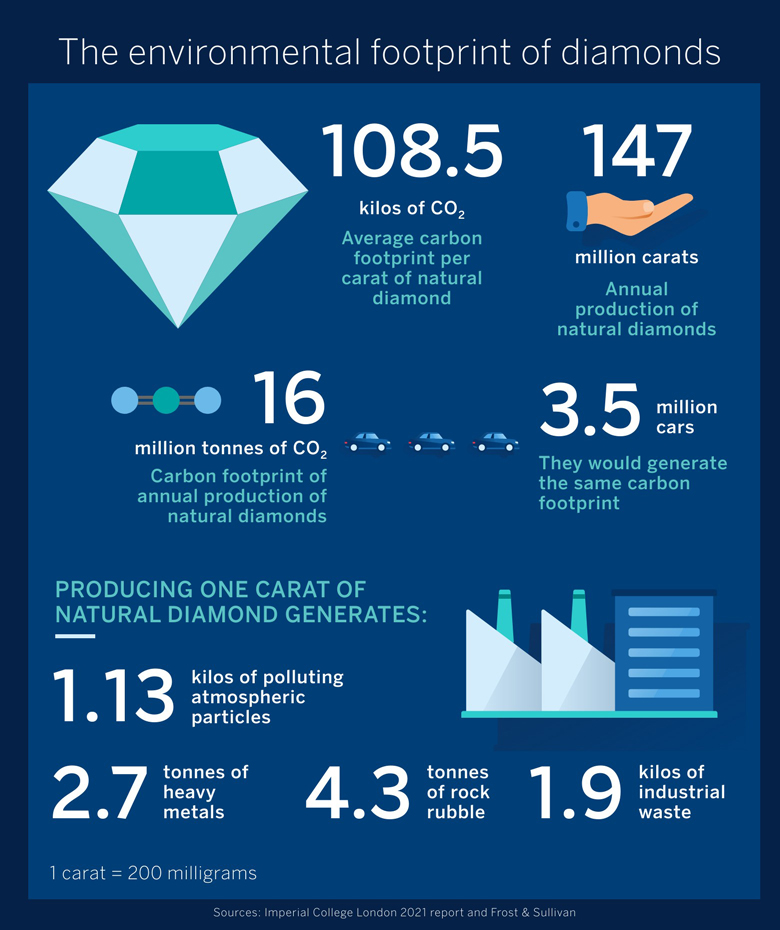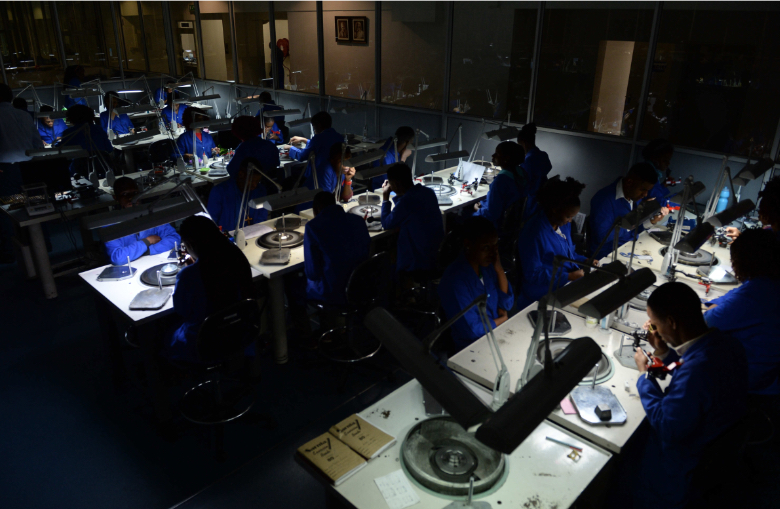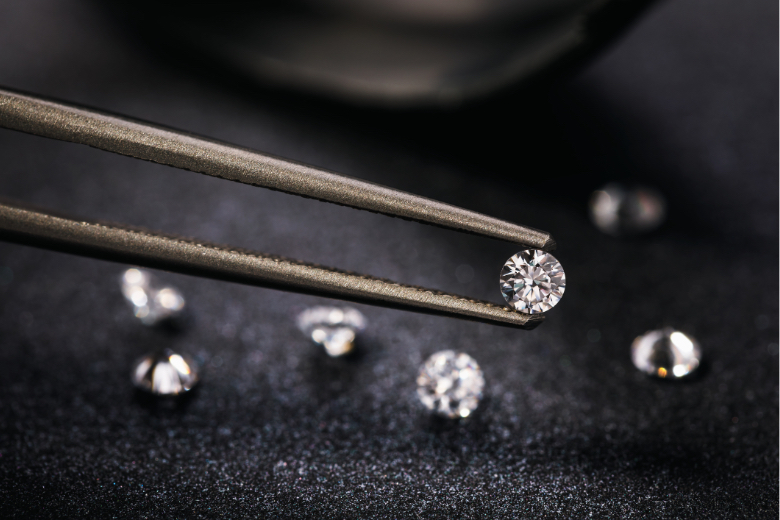Diamonds are a luxury item, so you might think that their environmental and climate footprint would be small. But when you consider that their estimated demand in 2022 was 178 million carats—more than 35 tonnes—which is forecast to grow by 65% by 2050, that 80% of mined diamonds are used for industrial purposes, and that 34% of diamonds used in jewellery are sold as engagement rings, it seems that their impact is much greater than we might think. Perhaps enough to raise questions about their sustainability, especially when artificial, non-mined alternatives are now available. So is there such a thing as a green diamond?

“A Diamond is Forever” is a phrase we associate with these gemstones, and indeed it has been one of the most successful advertising slogans in history, coined in 1947 by the copywriter Frances Gerety for the De Beers company, which enjoyed a monopoly for most of the 20th century with more than 80% of the world market. Interestingly, according to the International Gem Society, other gems such as rubies and sapphires used to be more highly prized, and it was De Beers’ advertising, aided by the song “Diamonds Are a Girl’s Best Friend” performed by Marilyn Monroe in the 1953 film Gentlemen Prefer Blondes, that boosted the popularity of these gems.
The cost of diamond mining
The late 20th century saw the scandal of the blood diamond (or conflict diamond), referring to diamonds obtained through gross human rights abuses and used to finance guerrilla warfare. This humanitarian tragedy overshadowed all other considerations. Since 2003, 85 countries and the diamond industry have signed up to a certification scheme called the Kimberley Process. And although experts and organisations argue that this is still not enough to clean up the industry, environmental and climate sustainability requirements are now also coming into play.

All mining is harmful to the environment, and diamond mining is carried out on four fronts: open pit, underground, river alluvial and marine. According to a 2021 report by Imperial College London (ICL), each carat (200 milligrams) has an average carbon footprint of 108.5 kilos of CO2. Applied to the report’s quoted production of 147 million carats in 2018, that would add up to about 16 million tonnes of CO2 per year, the equivalent of almost 3.5 million cars.
But that same carat requires the extraction of 1,000 tonnes of earth, the use of 101 kilowatt-hours of energy and the consumption of 3,900 litres of water, generating 1.13 kilos of atmospheric particulate pollutants, 2.7 tonnes of heavy metals, 4.3 tonnes of rock debris and 1.9 kilos of industrial waste, in addition to other emissions; to which must be added deforestation, destruction of the natural environment and health and safety impacts. Studies cited by ICL estimate an environmental cost (not an actual economic cost) of $42 per carat of polished diamond in large-scale mining, rising to $1,420 in artisanal alluvial mining due to health and safety costs.
Sustainable, carbon-neutral alternatives
Research into artificial manufacturing began in the late 19th century, and since the mid-20th century the two most widely used processes have been perfected: high-pressure, high-temperature (HPHT) and chemical vapour deposition (CVD), with others still in the experimental stage. Experts claim that these diamonds are identical to and indistinguishable from natural diamonds. And according to the consultancy Frost & Sullivan, they are a more sustainable alternative: they consume seven times less water, use less than half the energy, emit less than 5% of the CO2 of natural diamonds and do not alter ecosystems. And according to Clean Origin, one of the laboratories, they cost 30% less.

There are already manufacturers certified as carbon neutral, and companies such as Aether or Skydiamond even claim to have a negative carbon footprint, using CO2 captured from the atmosphere as a raw material. In collaboration with the Swiss carbon capture company Climeworks, Aether claims to remove 20 tonnes of CO2 from the atmosphere per carat.
For its part, the traditional industry has hit back, accusing the labs of exaggerating their environmental benefits, prompting the US Federal Trade Commission to issue a warning. According to an industry-commissioned report by consulting firm S&P Global, manufacturing in fossil fuel-dependent countries produces three times more emissions than mining, a claim disputed by academic experts. In the ICL report, Saleem Ali, professor of energy and environment at the University of Delaware, says the industry ignores full life-cycle data on diamond mining, and Gavin Mudd of Australia’s RMIT University said there is a lack of data because “the diamond mining industry is not used to the culture of transparency.”

Major jewellery brands such as Pandora have signed up for lab-grown diamonds. And while De Beers says it is committed to carbon-neutral mining by 2030, it is playing both sides of the fence, with a line of carbon-neutral lab-grown diamonds whose website makes no mention of the parent company. Experts say there is room for everyone; a more ethical and transparent extractive industry can create jobs and development in producing countries, as is the case in Botswana. And let the consumer decide, safe in the knowledge that whatever diamond they choose is forever.
Comments on this publication